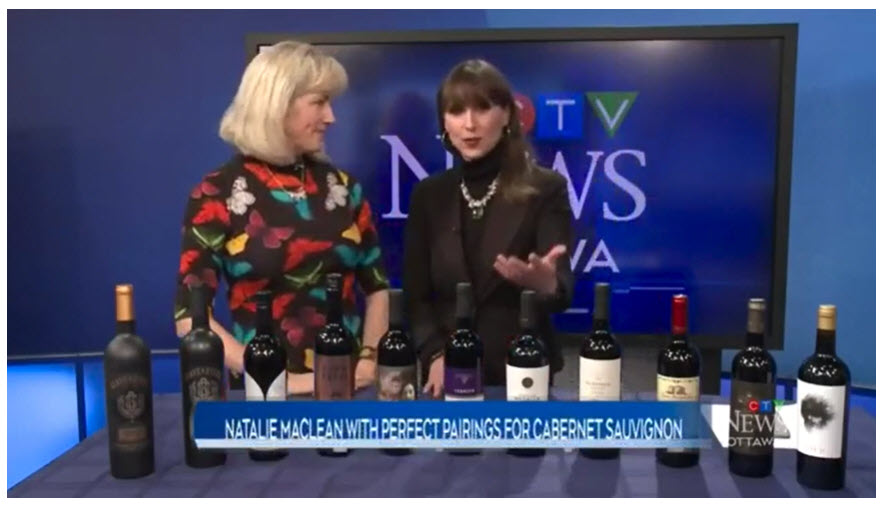Leanne and I chat about Cabernet Sauvignon in honour of Cabernet Day, the last Thursday before Labour Day… when we need something stronger in our glass than rose. ;)
Here are some quick facts you should know about Cabernet Sauvignon:
- Cabernet Sauvignon was originally created by crossing the white grape Sauvignon Blanc and the red grape Cabernet Franc. Cabernet Franc is the parent grape of both Merlot and Cabernet Sauvignon.
- Cabernet Sauvignon is most famous in Bordeaux, France, where it’s part of a blend that can include any or all of the following grapes to increase the complexity of the final wine: Merlot, Cabernet Franc, Malbec and Petite Verdot.
- In the US, these blends are called Meritage.
It’s often called a donut wine with strong flavour at first first and a long finish, but lacking in the mid-palate. Needs a fleshy red like Merlot to fill that flavour “hole.”
McWilliams Wines JJ McWilliam Shiraz Cabernet
South Eastern Australia, Australia
- It’s one of the world’s most popular wines and the most widely planted overall. Cabernet is also planted in many regions because its tough skin and a small grape size so it resists disease and rot.
- It’s often referred to as the king of wines because it’s full-bodied and deeply flavoured.
- Cabernet Sauvignon – Sauvignon means “wild” or savage referring to the brutal tannins. Tannins that dry feeling, not a taste, like eating walnuts. They bind with salvia, every sip makes your mouth feel dryer.
- Those tannins enable Cabernet Sauvignon to age for decades and smooth out over time as the wine becomes more complex and subtle as a result. Just how long it can age depends on how well it was made (quality of the fruit, etc).
- If you don’t have the patience or cellar space to age Cabernet, then decant it for an hour or two.
Chateau de Courteillac Merlot Cabernet Sauvignon
Bordeaux, France
- The Cabernet Sauvignon grape or berry is small so the ratio of the skin to flesh or pulp of the grape is higher than other grapes.
- That means it’s more flavourful and can age longer because the flavour compounds as well as the tannins are in the skins, so there’s more of them in the wine.
- Signature aromas in its youth include blackcurrant, cassis, blackberry, herbs and cedar or oak. Black fruit versus red fruit.
- As it ages, Cabernet Sauvignon takes on notes of seductive spices, anise, violets, leather, olive, tobacco and cigar box. It’s often aged in oak from 6-24 months.
Reif Estate Winery Cabernet Merlot
Niagara-on-the-Lake, Ontario V.Q.A., Canada
- When Cabernet goes wrong: If the grapes were not fully ripened when picked, it can have green bell pepper or weedy notes.
- There’s an aromatic compound in both Cabernet Sauvignon and Cabernet Franc that’s also found in green bell peppers called pyrazines — Merlot, Carmenere, Malbec and Sauvignon Blanc have it too.
- This is the grape’s natural defense against pests in its youth since it doesn’t taste great unlike the riper and sweeter flavours that emerge as the grape ripens.
- Don’t be afraid of the herbaceous notes, they can have a pleasant flavour when in balance with other riper flavours.
Louis M. Martini Cabernet Sauvignon
Sonoma County, California, United States
- What’s changing is that Cabernets in warm climates aren’t as over ripe as they used to be with extremely high alcohol levels of 14% or more. Too much oak and vanilla spice. Going more for balance and elegance.
- Top 5 producers worldwide: France, Chile, the U.S., Australia and Spain
- It does especially well in regions with warm, dry conditions and a long growing season such as California, Chile, Argentina and Australia.
Hester Creek Estate Winery The Judge Golden Mile Bench
Okanagan Valley, British Columbia BC V.Q.A. Canada
Posted with permission of CTV.













